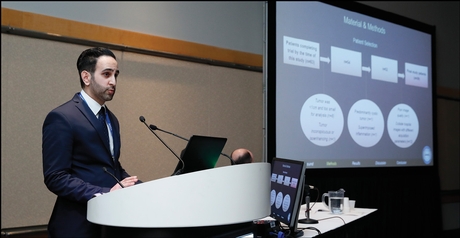CT Has Potential Role in Assessing Pancreatic Cancer Treatment
Monday, Nov. 27, 2017
CT-derived texture analysis of pancreatic tumors could help assess and predict a patient's response to chemotherapy, according to research presented Sunday.
Patients with pancreatic cancer, the fourth leading cause of cancer-related death in the United States, often undergo chemotherapy as part of their treatment, but not everyone responds to the treatment the same way. Imaging biomarkers that may predict pancreatic cancer chemotherapy response are lacking, said study author Rohit Dewan, DO, a clinical fellow at the University of Pittsburgh Medical Center in Pittsburgh, PA. A blood test that measures levels of CA 19-9, a substance released by pancreatic tumor cells, is often used to measure treatment response, but up to 10 percent of patients whose tumors are growing do not show an increase in CA 19-9 levels. In addition, imaging features like tumor size and vascularity are unreliable.

Dewan
Dr. Dewan and colleagues recently studied a novel approach to treatment response monitoring that focuses on the textural features of a tumor as derived from CT. They looked at 39 patients with early-stage cancer. The patients underwent CT before and after chemotherapy, and surgical resection was performed within five days of the second CT.
CT textural features were extracted from a region of interest on the largest tumor cross-section using commercially available software called TexRAD that produces textural variables like tumor skewness, kurtosis and entropy.
The researchers assessed surgical specimens for tumor histologic response using the Evans grading system, in which grade I represents no or minimal response and grade IV is a complete response. A biochemical response was defined as more than a 50-percent decrease in CA19-9 level. Correlation among textural parameters, tumor grade, Evans grade and biochemical response was assessed.
A statistically significant correlation was shown between specific textural variables such as tumor entropy, skewness and mean positive pixel on the initial CT scan and Evans grade of histological response. Tumor entropy on post-treatment CT as well as changes in tumor skewness correlated with Evans grade. Changes in tumor kurtosis and skewness also correlated with biochemical response.
"We found a significant correlation between the texture parameters in the region of interest and the tumor response to chemotherapy," Dr. Dewan said. "The results show that quantitative parameters of tumor heterogeneity on baseline CT are much better predictors of treatment effect than CA19-9."
Dr. Dewan noted that texture analysis may have particular importance for cases in which the pancreatic cancer is locally advanced, in which case it is treated with chemotherapy first followed by surgery. The information could easily be included in picture archive and communication systems, he said
"This approach has a lot of potential," Dr. Dewan said. "The software extracts several parameters, and in the future we hope to learn more about which variables are most important."
The researchers are planning on validating this method in larger cohorts and also look at the correlation with molecular and genetic markers of disease aggressiveness.




 Home
Home Program
Program
 Exhibitors
Exhibitors My Meeting
My Meeting
 Digital Posters
Digital Posters Case of Day
Case of Day

